Business Law: Shorten v Grafton District Golf Club & Acts Interpretation Legislations
VerifiedAdded on 2023/06/10
|6
|1798
|82
AI Summary
This article discusses the case of Shorten v Grafton District Golf Club and 9 Australian Acts Interpretation legislations. It also explains the difference between case law and legislation, academic misconduct and plagiarism.
Contribute Materials
Your contribution can guide someone’s learning journey. Share your
documents today.
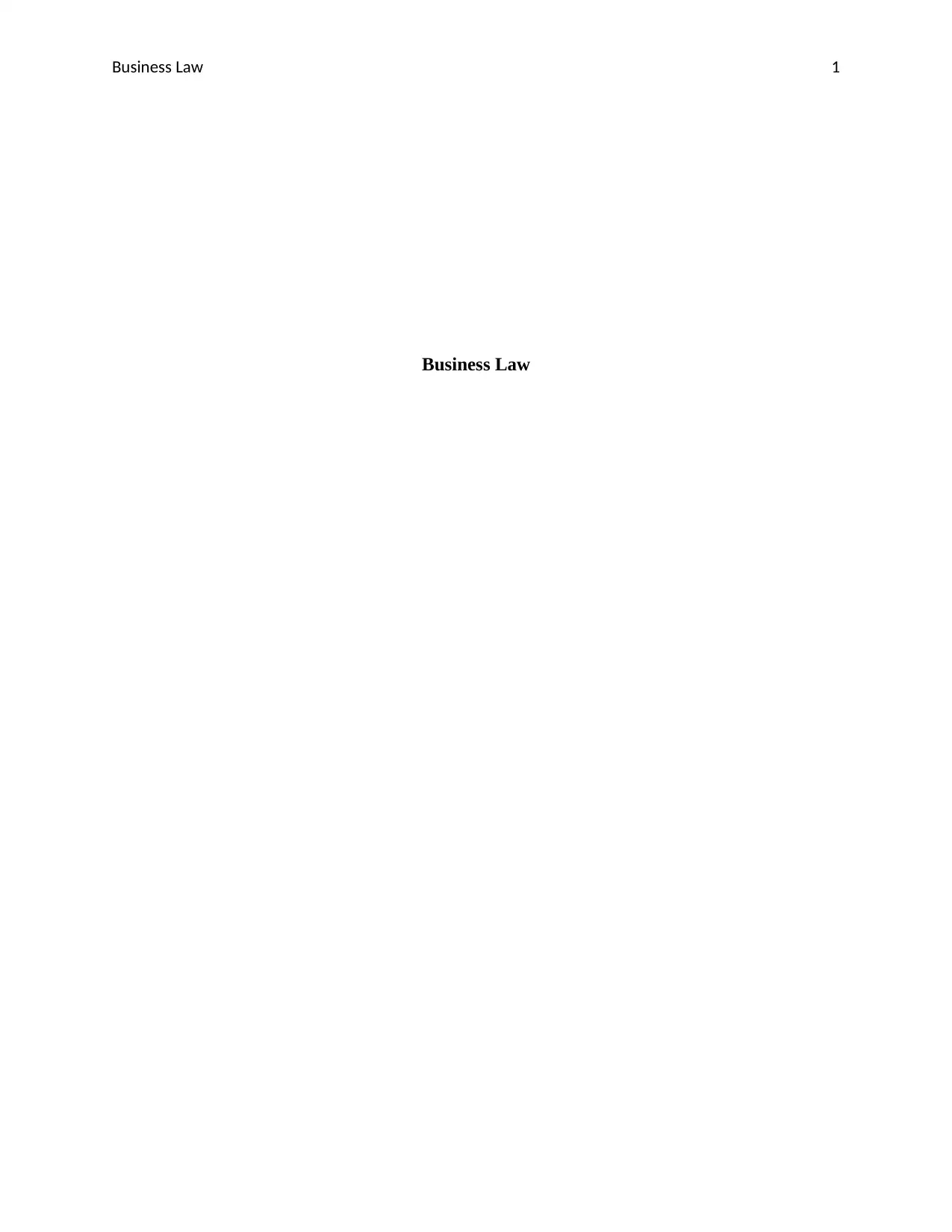
Business Law 1
Business Law
Business Law
Secure Best Marks with AI Grader
Need help grading? Try our AI Grader for instant feedback on your assignments.
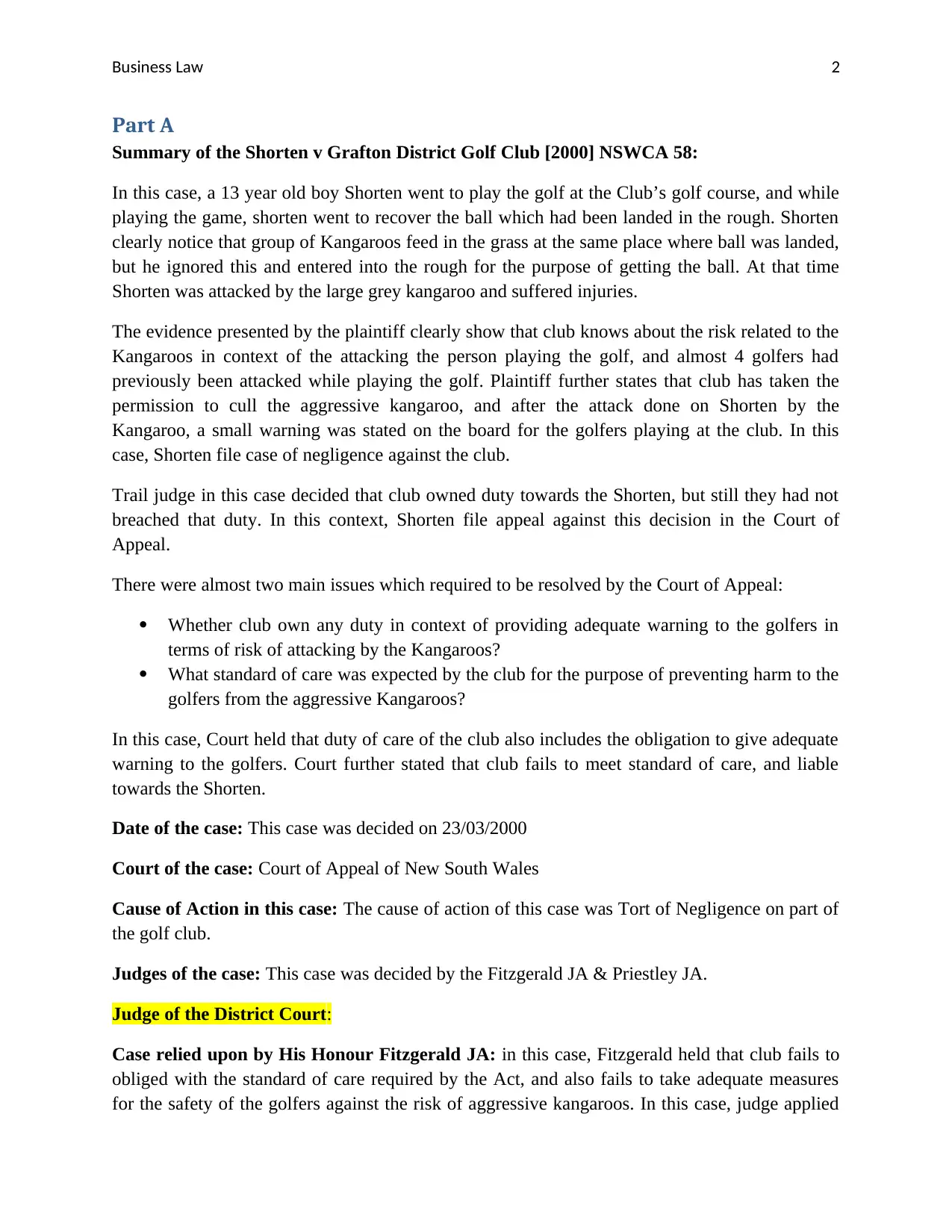
Business Law 2
Part A
Summary of the Shorten v Grafton District Golf Club [2000] NSWCA 58:
In this case, a 13 year old boy Shorten went to play the golf at the Club’s golf course, and while
playing the game, shorten went to recover the ball which had been landed in the rough. Shorten
clearly notice that group of Kangaroos feed in the grass at the same place where ball was landed,
but he ignored this and entered into the rough for the purpose of getting the ball. At that time
Shorten was attacked by the large grey kangaroo and suffered injuries.
The evidence presented by the plaintiff clearly show that club knows about the risk related to the
Kangaroos in context of the attacking the person playing the golf, and almost 4 golfers had
previously been attacked while playing the golf. Plaintiff further states that club has taken the
permission to cull the aggressive kangaroo, and after the attack done on Shorten by the
Kangaroo, a small warning was stated on the board for the golfers playing at the club. In this
case, Shorten file case of negligence against the club.
Trail judge in this case decided that club owned duty towards the Shorten, but still they had not
breached that duty. In this context, Shorten file appeal against this decision in the Court of
Appeal.
There were almost two main issues which required to be resolved by the Court of Appeal:
Whether club own any duty in context of providing adequate warning to the golfers in
terms of risk of attacking by the Kangaroos?
What standard of care was expected by the club for the purpose of preventing harm to the
golfers from the aggressive Kangaroos?
In this case, Court held that duty of care of the club also includes the obligation to give adequate
warning to the golfers. Court further stated that club fails to meet standard of care, and liable
towards the Shorten.
Date of the case: This case was decided on 23/03/2000
Court of the case: Court of Appeal of New South Wales
Cause of Action in this case: The cause of action of this case was Tort of Negligence on part of
the golf club.
Judges of the case: This case was decided by the Fitzgerald JA & Priestley JA.
Judge of the District Court:
Case relied upon by His Honour Fitzgerald JA: in this case, Fitzgerald held that club fails to
obliged with the standard of care required by the Act, and also fails to take adequate measures
for the safety of the golfers against the risk of aggressive kangaroos. In this case, judge applied
Part A
Summary of the Shorten v Grafton District Golf Club [2000] NSWCA 58:
In this case, a 13 year old boy Shorten went to play the golf at the Club’s golf course, and while
playing the game, shorten went to recover the ball which had been landed in the rough. Shorten
clearly notice that group of Kangaroos feed in the grass at the same place where ball was landed,
but he ignored this and entered into the rough for the purpose of getting the ball. At that time
Shorten was attacked by the large grey kangaroo and suffered injuries.
The evidence presented by the plaintiff clearly show that club knows about the risk related to the
Kangaroos in context of the attacking the person playing the golf, and almost 4 golfers had
previously been attacked while playing the golf. Plaintiff further states that club has taken the
permission to cull the aggressive kangaroo, and after the attack done on Shorten by the
Kangaroo, a small warning was stated on the board for the golfers playing at the club. In this
case, Shorten file case of negligence against the club.
Trail judge in this case decided that club owned duty towards the Shorten, but still they had not
breached that duty. In this context, Shorten file appeal against this decision in the Court of
Appeal.
There were almost two main issues which required to be resolved by the Court of Appeal:
Whether club own any duty in context of providing adequate warning to the golfers in
terms of risk of attacking by the Kangaroos?
What standard of care was expected by the club for the purpose of preventing harm to the
golfers from the aggressive Kangaroos?
In this case, Court held that duty of care of the club also includes the obligation to give adequate
warning to the golfers. Court further stated that club fails to meet standard of care, and liable
towards the Shorten.
Date of the case: This case was decided on 23/03/2000
Court of the case: Court of Appeal of New South Wales
Cause of Action in this case: The cause of action of this case was Tort of Negligence on part of
the golf club.
Judges of the case: This case was decided by the Fitzgerald JA & Priestley JA.
Judge of the District Court:
Case relied upon by His Honour Fitzgerald JA: in this case, Fitzgerald held that club fails to
obliged with the standard of care required by the Act, and also fails to take adequate measures
for the safety of the golfers against the risk of aggressive kangaroos. In this case, judge applied
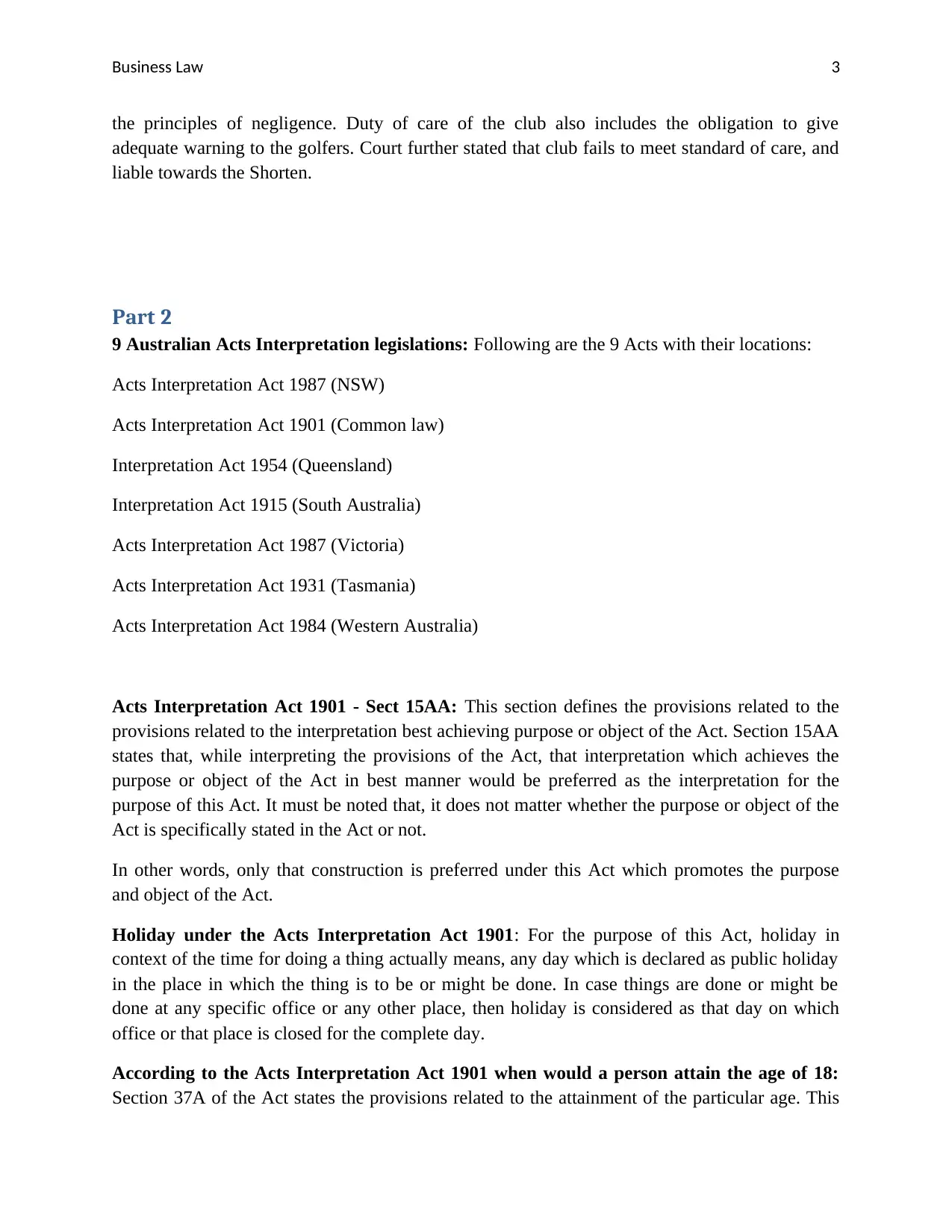
Business Law 3
the principles of negligence. Duty of care of the club also includes the obligation to give
adequate warning to the golfers. Court further stated that club fails to meet standard of care, and
liable towards the Shorten.
Part 2
9 Australian Acts Interpretation legislations: Following are the 9 Acts with their locations:
Acts Interpretation Act 1987 (NSW)
Acts Interpretation Act 1901 (Common law)
Interpretation Act 1954 (Queensland)
Interpretation Act 1915 (South Australia)
Acts Interpretation Act 1987 (Victoria)
Acts Interpretation Act 1931 (Tasmania)
Acts Interpretation Act 1984 (Western Australia)
Acts Interpretation Act 1901 - Sect 15AA: This section defines the provisions related to the
provisions related to the interpretation best achieving purpose or object of the Act. Section 15AA
states that, while interpreting the provisions of the Act, that interpretation which achieves the
purpose or object of the Act in best manner would be preferred as the interpretation for the
purpose of this Act. It must be noted that, it does not matter whether the purpose or object of the
Act is specifically stated in the Act or not.
In other words, only that construction is preferred under this Act which promotes the purpose
and object of the Act.
Holiday under the Acts Interpretation Act 1901: For the purpose of this Act, holiday in
context of the time for doing a thing actually means, any day which is declared as public holiday
in the place in which the thing is to be or might be done. In case things are done or might be
done at any specific office or any other place, then holiday is considered as that day on which
office or that place is closed for the complete day.
According to the Acts Interpretation Act 1901 when would a person attain the age of 18:
Section 37A of the Act states the provisions related to the attainment of the particular age. This
the principles of negligence. Duty of care of the club also includes the obligation to give
adequate warning to the golfers. Court further stated that club fails to meet standard of care, and
liable towards the Shorten.
Part 2
9 Australian Acts Interpretation legislations: Following are the 9 Acts with their locations:
Acts Interpretation Act 1987 (NSW)
Acts Interpretation Act 1901 (Common law)
Interpretation Act 1954 (Queensland)
Interpretation Act 1915 (South Australia)
Acts Interpretation Act 1987 (Victoria)
Acts Interpretation Act 1931 (Tasmania)
Acts Interpretation Act 1984 (Western Australia)
Acts Interpretation Act 1901 - Sect 15AA: This section defines the provisions related to the
provisions related to the interpretation best achieving purpose or object of the Act. Section 15AA
states that, while interpreting the provisions of the Act, that interpretation which achieves the
purpose or object of the Act in best manner would be preferred as the interpretation for the
purpose of this Act. It must be noted that, it does not matter whether the purpose or object of the
Act is specifically stated in the Act or not.
In other words, only that construction is preferred under this Act which promotes the purpose
and object of the Act.
Holiday under the Acts Interpretation Act 1901: For the purpose of this Act, holiday in
context of the time for doing a thing actually means, any day which is declared as public holiday
in the place in which the thing is to be or might be done. In case things are done or might be
done at any specific office or any other place, then holiday is considered as that day on which
office or that place is closed for the complete day.
According to the Acts Interpretation Act 1901 when would a person attain the age of 18:
Section 37A of the Act states the provisions related to the attainment of the particular age. This
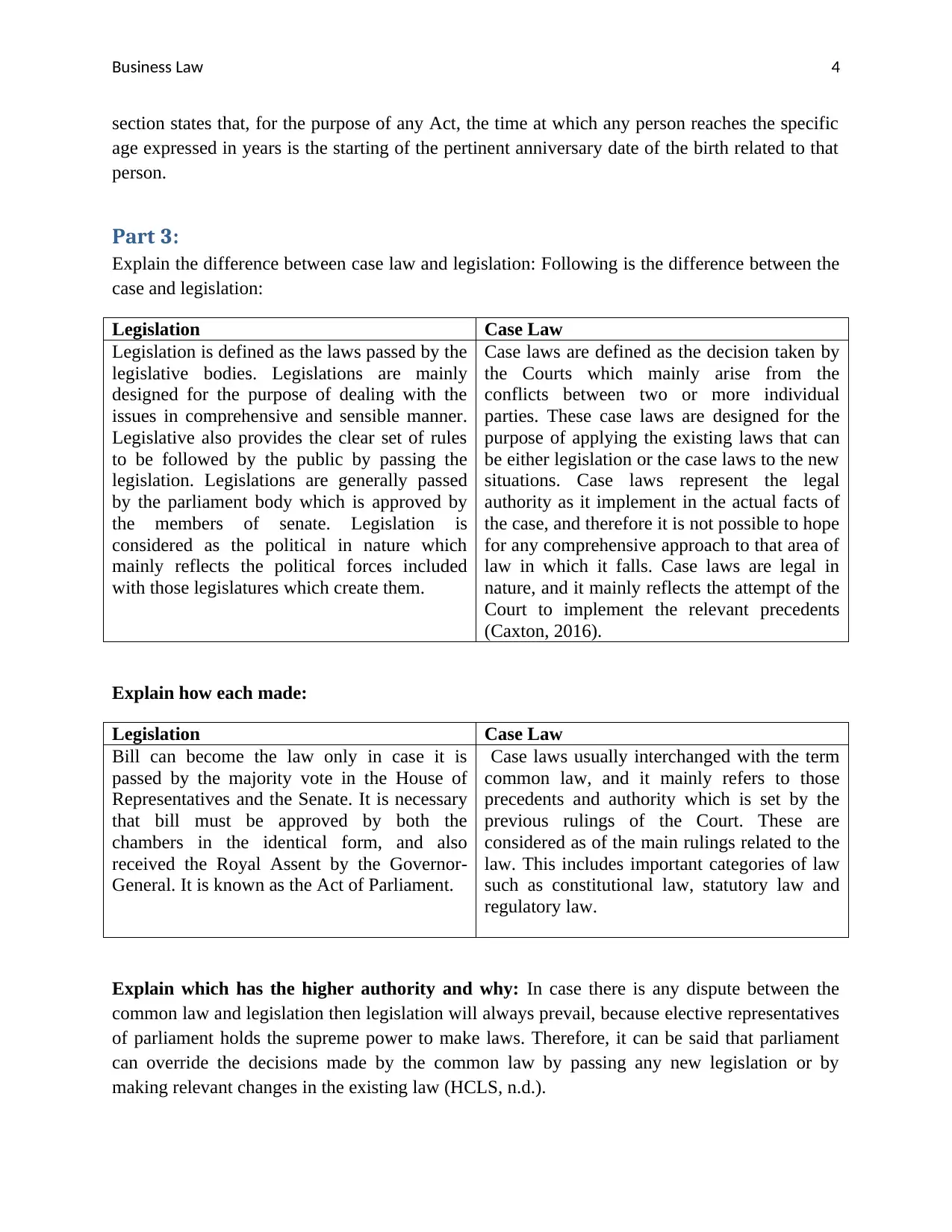
Business Law 4
section states that, for the purpose of any Act, the time at which any person reaches the specific
age expressed in years is the starting of the pertinent anniversary date of the birth related to that
person.
Part 3:
Explain the difference between case law and legislation: Following is the difference between the
case and legislation:
Legislation Case Law
Legislation is defined as the laws passed by the
legislative bodies. Legislations are mainly
designed for the purpose of dealing with the
issues in comprehensive and sensible manner.
Legislative also provides the clear set of rules
to be followed by the public by passing the
legislation. Legislations are generally passed
by the parliament body which is approved by
the members of senate. Legislation is
considered as the political in nature which
mainly reflects the political forces included
with those legislatures which create them.
Case laws are defined as the decision taken by
the Courts which mainly arise from the
conflicts between two or more individual
parties. These case laws are designed for the
purpose of applying the existing laws that can
be either legislation or the case laws to the new
situations. Case laws represent the legal
authority as it implement in the actual facts of
the case, and therefore it is not possible to hope
for any comprehensive approach to that area of
law in which it falls. Case laws are legal in
nature, and it mainly reflects the attempt of the
Court to implement the relevant precedents
(Caxton, 2016).
Explain how each made:
Legislation Case Law
Bill can become the law only in case it is
passed by the majority vote in the House of
Representatives and the Senate. It is necessary
that bill must be approved by both the
chambers in the identical form, and also
received the Royal Assent by the Governor-
General. It is known as the Act of Parliament.
Case laws usually interchanged with the term
common law, and it mainly refers to those
precedents and authority which is set by the
previous rulings of the Court. These are
considered as of the main rulings related to the
law. This includes important categories of law
such as constitutional law, statutory law and
regulatory law.
Explain which has the higher authority and why: In case there is any dispute between the
common law and legislation then legislation will always prevail, because elective representatives
of parliament holds the supreme power to make laws. Therefore, it can be said that parliament
can override the decisions made by the common law by passing any new legislation or by
making relevant changes in the existing law (HCLS, n.d.).
section states that, for the purpose of any Act, the time at which any person reaches the specific
age expressed in years is the starting of the pertinent anniversary date of the birth related to that
person.
Part 3:
Explain the difference between case law and legislation: Following is the difference between the
case and legislation:
Legislation Case Law
Legislation is defined as the laws passed by the
legislative bodies. Legislations are mainly
designed for the purpose of dealing with the
issues in comprehensive and sensible manner.
Legislative also provides the clear set of rules
to be followed by the public by passing the
legislation. Legislations are generally passed
by the parliament body which is approved by
the members of senate. Legislation is
considered as the political in nature which
mainly reflects the political forces included
with those legislatures which create them.
Case laws are defined as the decision taken by
the Courts which mainly arise from the
conflicts between two or more individual
parties. These case laws are designed for the
purpose of applying the existing laws that can
be either legislation or the case laws to the new
situations. Case laws represent the legal
authority as it implement in the actual facts of
the case, and therefore it is not possible to hope
for any comprehensive approach to that area of
law in which it falls. Case laws are legal in
nature, and it mainly reflects the attempt of the
Court to implement the relevant precedents
(Caxton, 2016).
Explain how each made:
Legislation Case Law
Bill can become the law only in case it is
passed by the majority vote in the House of
Representatives and the Senate. It is necessary
that bill must be approved by both the
chambers in the identical form, and also
received the Royal Assent by the Governor-
General. It is known as the Act of Parliament.
Case laws usually interchanged with the term
common law, and it mainly refers to those
precedents and authority which is set by the
previous rulings of the Court. These are
considered as of the main rulings related to the
law. This includes important categories of law
such as constitutional law, statutory law and
regulatory law.
Explain which has the higher authority and why: In case there is any dispute between the
common law and legislation then legislation will always prevail, because elective representatives
of parliament holds the supreme power to make laws. Therefore, it can be said that parliament
can override the decisions made by the common law by passing any new legislation or by
making relevant changes in the existing law (HCLS, n.d.).
Secure Best Marks with AI Grader
Need help grading? Try our AI Grader for instant feedback on your assignments.
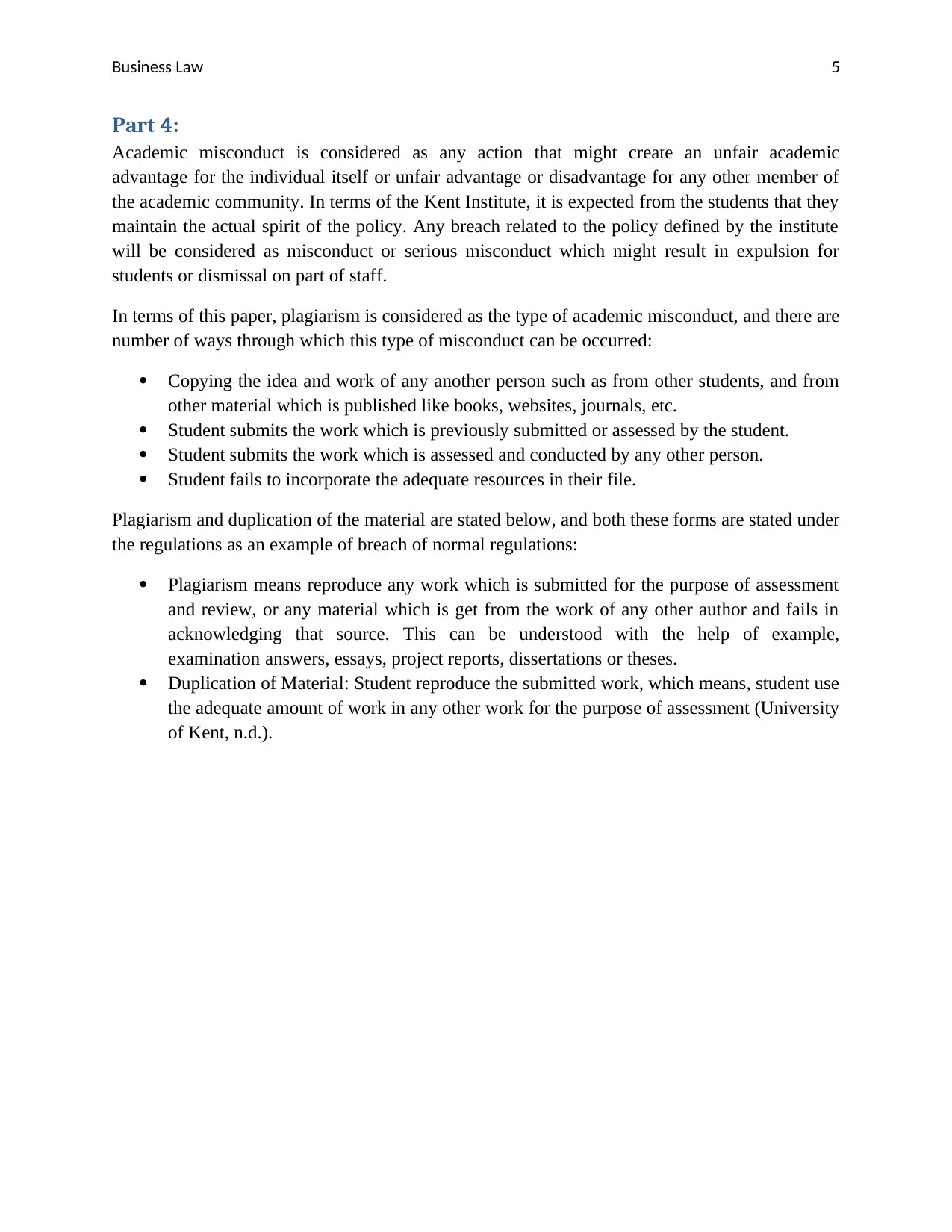
Business Law 5
Part 4:
Academic misconduct is considered as any action that might create an unfair academic
advantage for the individual itself or unfair advantage or disadvantage for any other member of
the academic community. In terms of the Kent Institute, it is expected from the students that they
maintain the actual spirit of the policy. Any breach related to the policy defined by the institute
will be considered as misconduct or serious misconduct which might result in expulsion for
students or dismissal on part of staff.
In terms of this paper, plagiarism is considered as the type of academic misconduct, and there are
number of ways through which this type of misconduct can be occurred:
Copying the idea and work of any another person such as from other students, and from
other material which is published like books, websites, journals, etc.
Student submits the work which is previously submitted or assessed by the student.
Student submits the work which is assessed and conducted by any other person.
Student fails to incorporate the adequate resources in their file.
Plagiarism and duplication of the material are stated below, and both these forms are stated under
the regulations as an example of breach of normal regulations:
Plagiarism means reproduce any work which is submitted for the purpose of assessment
and review, or any material which is get from the work of any other author and fails in
acknowledging that source. This can be understood with the help of example,
examination answers, essays, project reports, dissertations or theses.
Duplication of Material: Student reproduce the submitted work, which means, student use
the adequate amount of work in any other work for the purpose of assessment (University
of Kent, n.d.).
Part 4:
Academic misconduct is considered as any action that might create an unfair academic
advantage for the individual itself or unfair advantage or disadvantage for any other member of
the academic community. In terms of the Kent Institute, it is expected from the students that they
maintain the actual spirit of the policy. Any breach related to the policy defined by the institute
will be considered as misconduct or serious misconduct which might result in expulsion for
students or dismissal on part of staff.
In terms of this paper, plagiarism is considered as the type of academic misconduct, and there are
number of ways through which this type of misconduct can be occurred:
Copying the idea and work of any another person such as from other students, and from
other material which is published like books, websites, journals, etc.
Student submits the work which is previously submitted or assessed by the student.
Student submits the work which is assessed and conducted by any other person.
Student fails to incorporate the adequate resources in their file.
Plagiarism and duplication of the material are stated below, and both these forms are stated under
the regulations as an example of breach of normal regulations:
Plagiarism means reproduce any work which is submitted for the purpose of assessment
and review, or any material which is get from the work of any other author and fails in
acknowledging that source. This can be understood with the help of example,
examination answers, essays, project reports, dissertations or theses.
Duplication of Material: Student reproduce the submitted work, which means, student use
the adequate amount of work in any other work for the purpose of assessment (University
of Kent, n.d.).
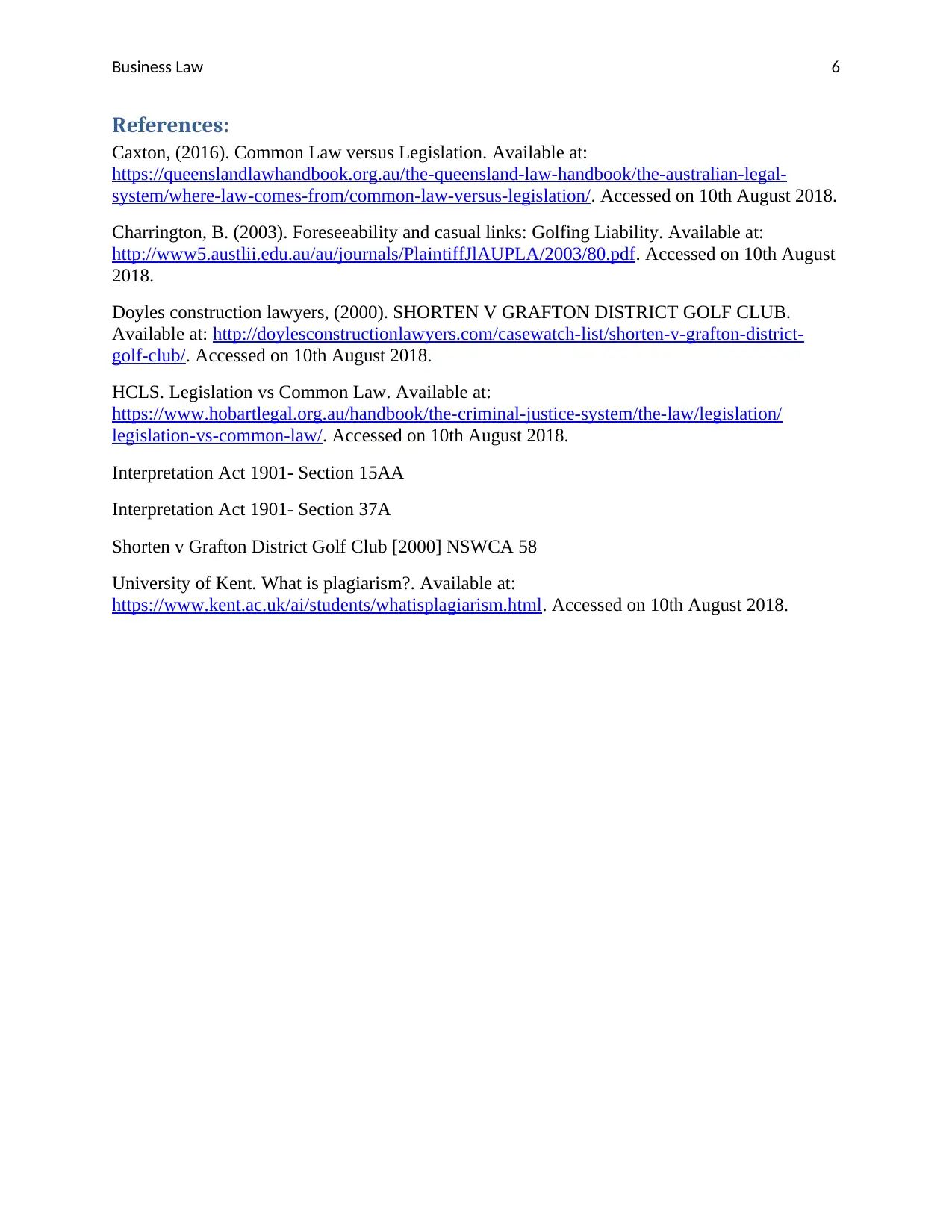
Business Law 6
References:
Caxton, (2016). Common Law versus Legislation. Available at:
https://queenslandlawhandbook.org.au/the-queensland-law-handbook/the-australian-legal-
system/where-law-comes-from/common-law-versus-legislation/. Accessed on 10th August 2018.
Charrington, B. (2003). Foreseeability and casual links: Golfing Liability. Available at:
http://www5.austlii.edu.au/au/journals/PlaintiffJlAUPLA/2003/80.pdf. Accessed on 10th August
2018.
Doyles construction lawyers, (2000). SHORTEN V GRAFTON DISTRICT GOLF CLUB.
Available at: http://doylesconstructionlawyers.com/casewatch-list/shorten-v-grafton-district-
golf-club/. Accessed on 10th August 2018.
HCLS. Legislation vs Common Law. Available at:
https://www.hobartlegal.org.au/handbook/the-criminal-justice-system/the-law/legislation/
legislation-vs-common-law/. Accessed on 10th August 2018.
Interpretation Act 1901- Section 15AA
Interpretation Act 1901- Section 37A
Shorten v Grafton District Golf Club [2000] NSWCA 58
University of Kent. What is plagiarism?. Available at:
https://www.kent.ac.uk/ai/students/whatisplagiarism.html. Accessed on 10th August 2018.
References:
Caxton, (2016). Common Law versus Legislation. Available at:
https://queenslandlawhandbook.org.au/the-queensland-law-handbook/the-australian-legal-
system/where-law-comes-from/common-law-versus-legislation/. Accessed on 10th August 2018.
Charrington, B. (2003). Foreseeability and casual links: Golfing Liability. Available at:
http://www5.austlii.edu.au/au/journals/PlaintiffJlAUPLA/2003/80.pdf. Accessed on 10th August
2018.
Doyles construction lawyers, (2000). SHORTEN V GRAFTON DISTRICT GOLF CLUB.
Available at: http://doylesconstructionlawyers.com/casewatch-list/shorten-v-grafton-district-
golf-club/. Accessed on 10th August 2018.
HCLS. Legislation vs Common Law. Available at:
https://www.hobartlegal.org.au/handbook/the-criminal-justice-system/the-law/legislation/
legislation-vs-common-law/. Accessed on 10th August 2018.
Interpretation Act 1901- Section 15AA
Interpretation Act 1901- Section 37A
Shorten v Grafton District Golf Club [2000] NSWCA 58
University of Kent. What is plagiarism?. Available at:
https://www.kent.ac.uk/ai/students/whatisplagiarism.html. Accessed on 10th August 2018.
1 out of 6
Related Documents
Your All-in-One AI-Powered Toolkit for Academic Success.
+13062052269
info@desklib.com
Available 24*7 on WhatsApp / Email
![[object Object]](/_next/static/media/star-bottom.7253800d.svg)
Unlock your academic potential
© 2024 | Zucol Services PVT LTD | All rights reserved.



